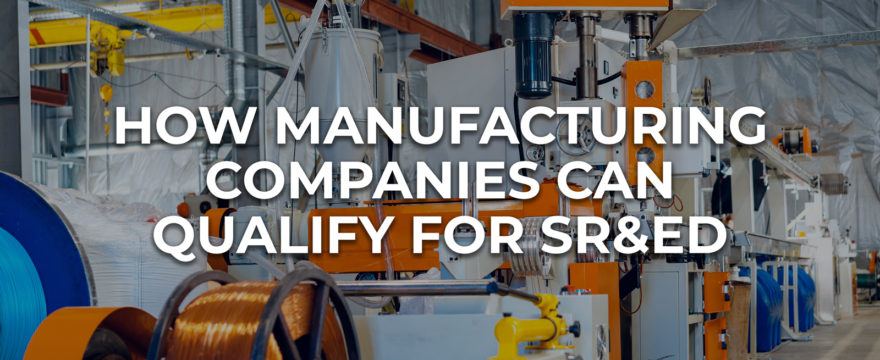
The Canada Revenue Agency’s (CRA’s) Scientific Research and Experimental Development (SR&ED) tax credit is well-known for the support it provides to tech companies. What you may not know is that the program is open to businesses conducting research and development (R&D) in any field, so long as those activities meet certain standards. Eligibility extends to the manufacturing sector, which in 2001 accounted for 64% of business R&D in Canada but today accounts for just 29%.
This drop is attributable to many factors, from an increasingly digital economy to the high costs of R&D in manufacturing. If your business engages in activities that are eligible for the SR&ED tax credit but doesn’t submit a claim to reimburse the costs, it’s missing out on a valuable source of capital. As manufacturers, your company must understand how you can qualify for R&D refunds that help cover the costs of wages, materials, and other expenses to make innovation more affordable.
How the SR&ED Tax Credit Applies in the Manufacturing Sector
Per Industry Canada, the manufacturing sector includes businesses primarily engaged in:
The physical or chemical transformation of materials or substances into new products. These products may be finished, in the sense that they are ready to be used or consumed, or semi-finished, in the sense of becoming a raw material for an establishment to use in further manufacturing.
This definition further encompasses a variety of related activities, including the assembly of components, blending of materials, and finishing of products. With this definition in mind, it’s easy to see why R&D is so important for the manufacturing sector’s growth. Remaining competitive in a challenging landscape demands constant innovation. With refunds of up to 65% of eligible SR&ED expenditure, the SR&ED tax credit makes it possible to fuel the innovation needed to stay one step ahead.
Manufacturing Sector Activities that Qualify for R&D Tax Credits
Eligibility criteria for the SR&ED tax credit are the same across all industries and focus on a company’s R&D qualifying activities and how they are conducted. Your team must utilize a systematic approach to identify a need and develop a proposed solution. That need must reflect a genuine scientific or technological uncertainty that cannot be solved by any existing product, process, or material.
What isn’t an eligibility requirement is that your SR&ED project succeeds. Rather than rewarding successful advancements, the CRA strives to encourage R&D work regardless of commercial viability and the success of the outcome. The goal is instead to encourage technological advancement in Canada by Canadian companies to build a reputation as a major innovator on the global stage.
A few activities that could qualify for the SR&ED tax credit include:
- Developing new applications for components not designed to work together
- Combining materials in new and innovative ways
- Establishing new finishing procedures and processes that represent a technological advancement
- Reformatting and/or adjusting products to produce a specific objective not previously achieved
- Reformulating equipment to achieve a new objective
Devising a new process could also qualify for the R&D tax credit. By creating a new solution to a safety hazard or challenge, for example, your activities may meet the criteria established for the SR&ED program.
Understanding What Doesn’t Qualify for the SR&ED Tax Credit
While there’s a good chance your R&D work may qualify, not all R&D activities are SR&ED activities. Manufacturers should verify the eligibility of their projects and expenditures incurred before submitting their SR&ED claims to avoid delays in receipt of their SR&ED refunds.
The following activities are not eligible for SR&ED:
- Quality control
- Routine testing of processes, products, materials, and devices
- Commercial development and production of a new or improved product or the use of such a product
The SR&ED tax credit is also unavailable for activities related to drilling for, prospecting, and/or production of minerals, petroleum, or natural gas. However, if your business manufactures equipment for these practices or supports the discovery and exploitation of natural resources, R&D work may qualify.
Manufacturing R&D Expenses that Are Eligible for the SR&ED Tax Credit
Just as you must know which R&D activities qualify for SR&ED, you must also understand which expenses may be claimed. Poorly documented expenditures and non-qualifying expenses are a sure way to delay a refund or find your claim denied, making it essential to know what can and cannot be submitted.
Manufacturing R&D tax credit qualified activities could include:
- Materials that are transformed or consumed during eligible activities
- Prototypes developed from such materials
- Wages paid to employees conducting R&D activities
- Engineering and design
- Mathematical analysis
- Computer programming
- Data collection
- Psychological research
Expenses related to work performed under contract by third parties may also be included, but these expenditures are reimbursed at 80%. Keeping detailed records of expenses, work performed, and methods used is the best way to receive the full value of your SR&ED claim.
Essential Capital Financing for the Manufacturing Sector
While the SR&ED tax credit offers a generous source of funding for R&D work, reimbursement is slow, and claims can’t be submitted until the end of the tax year. If your R&D capital needs can’t wait for tax returns, Easly’s Capital-as-a-Service (CaaS) platform can help.
Get started today to receive your first refund in just 72 hours after approval.
.png)
.png)
.png)
